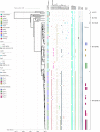Escherichia coli Sequence Type 410 Is Causing New International High-Risk Clones
- PMID: 30021879
- PMCID: PMC6052333
- DOI: 10.1128/mSphere.00337-18
Escherichia coli Sequence Type 410 Is Causing New International High-Risk Clones
Abstract
Escherichia coli sequence type 410 (ST410) has been reported worldwide as an extraintestinal pathogen associated with resistance to fluoroquinolones, third-generation cephalosporins, and carbapenems. In the present study, we investigated national epidemiology of ST410 E. coli isolates from Danish patients. Furthermore, E. coli ST410 was investigated in a global context to provide further insight into the acquisition of the carbapenemase genes blaOXA-181 and blaNDM-5 of this successful lineage. From 127 whole-genome-sequenced isolates, we reconstructed an evolutionary framework of E. coli ST410 which portrays the antimicrobial-resistant clades B2/H24R, B3/H24Rx, and B4/H24RxC. The B2/H24R and B3/H24Rx clades emerged around 1987, concurrently with the C1/H30R and C2/H30Rx clades in E. coli ST131. B3/H24Rx appears to have evolved by the acquisition of the extended-spectrum β-lactamase (ESBL)-encoding gene blaCTX-M-15 and an IncFII plasmid, encoding IncFIA and IncFIB. Around 2003, the carbapenem-resistant clade B4/H24RxC emerged when ST410 acquired an IncX3 plasmid carrying a blaOXA-181 carbapenemase gene. Around 2014, the clade B4/H24RxC acquired a second carbapenemase gene, blaNDM-5, on a conserved IncFII plasmid. From an epidemiological investigation of 49 E. coli ST410 isolates from Danish patients, we identified five possible regional outbreaks, of which one outbreak involved nine patients with blaOXA-181- and blaNDM-5-carrying B4/H24RxC isolates. The accumulated multidrug resistance in E. coli ST410 over the past two decades, together with its proven potential of transmission between patients, poses a high risk in clinical settings, and thus, E. coli ST410 should be considered a lineage with emerging "high-risk" clones, which should be monitored closely in the future.IMPORTANCE Extraintestinal pathogenic Escherichia coli (ExPEC) is the main cause of urinary tract infections and septicemia. Significant attention has been given to the ExPEC sequence type ST131, which has been categorized as a "high-risk" clone. High-risk clones are globally distributed clones associated with various antimicrobial resistance determinants, ease of transmission, persistence in hosts, and effective transmission between hosts. The high-risk clones have enhanced pathogenicity and cause severe and/or recurrent infections. We show that clones of the E. coli ST410 lineage persist and/or cause recurrent infections in humans, including bloodstream infections. We found evidence of ST410 being a highly resistant globally distributed lineage, capable of patient-to-patient transmission causing hospital outbreaks. Our analysis suggests that the ST410 lineage should be classified with the potential to cause new high-risk clones. Thus, with the clonal expansion over the past decades and increased antimicrobial resistance to last-resort treatment options, ST410 needs to be monitored prospectively.
Keywords: BEAST; Escherichia coli; epidemiology; evolution; high-risk clone; outbreak.
Copyright © 2018 Roer et al.
Figures



References
-
- Price LB, Johnson JR, Aziz M, Clabots C, Johnston B, Tchesnokova V, Nordstrom L, Billig M, Chattopadhyay S, Stegger M, Andersen PS, Pearson T, Riddell K, Rogers P, Scholes D, Kahl B, Keim P, Sokurenko EV. 2013. The epidemic of extended-spectrum-β-lactamase-producing Escherichia coli ST131 is driven by a single highly pathogenic subclone, H30-Rx. mBio 4:e00377-13. doi:10.1128/mBio.00377-13. - DOI - PMC - PubMed
-
- Ben Zakour NL, Alsheikh-Hussain AS, Ashcroft MM, Khanh Nhu NT, Roberts LW, Stanton-Cook M, Schembri MA, Beatson SA. 2016. Sequential acquisition of virulence and fluoroquinolone resistance has shaped the evolution of Escherichia coli ST131. mBio 7:e00347-16. doi:10.1128/mBio.00347-16. - DOI - PMC - PubMed
-
- Schaufler K, Semmler T, Wieler LH, Wöhrmann M, Baddam R, Ahmed N, Müller K, Kola A, Fruth A, Ewers C, Guenther S. 2016. Clonal spread and interspecies transmission of clinically relevant ESBL-producing Escherichia coli of ST410—another successful pandemic clone? FEMS Microbiol Ecol 92:fiv155. doi:10.1093/femsec/fiv155. - DOI - PubMed
Publication types
MeSH terms
Substances
LinkOut - more resources
Full Text Sources
Other Literature Sources
Medical
Miscellaneous
